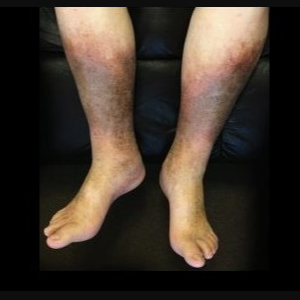Lymphedema and Weight Loss
Living with lymphedema while trying to manage your weight can feel overwhelming, but understanding the connection between lymphedema and weight loss can help you develop effective strategies for both conditions.
Read More

Your veins keep blood circulating throughout your body. Normally, blood flow to your limbs is controlled by one-way valves that help propel your blood back to your heart. Sometimes these valves stop functioning, allowing blood to pool in the legs, which can progress to a condition called chronic venous insufficiency (CVI). If not treated, CVI often causes lymphedema, which leads to swelling and skin changes.
Chronic venous disease is a progressive condition. This means it cannot be cured, and often gets worse over time. However, when identified early and treated consistently, CVI can be managed effectively at home.
Doctors have identified four common stages of chronic venous disease. You can be diagnosed and treated at any stage.
Your veins may be visible with some discoloration (spider veins) but the lymphatic system is not affected and there is very little swelling.
Your veins may protrude (varicose veins) and your legs may feel uncomfortable.
You’ll experience significant swelling (edema), as stagnant proteins pool in the legs, which could be lymphedema, and the likelihood of infection increases.
As CVI and lymphedema progress, you’ll start to see changes to your skin, including discoloration, eczema, fibrosis (hardening), and highly visible discolored veins may develop.
You’ll start to have open wounds (ulcers) that are slow to heal, and fat deposits will start to appear.
Chronic venous disease typically appears with one or more of the following signs and symptoms:
You can take control of your chronic venous disease and accompanying lymphedema by carefully following the treatment plan outlined by your doctor, which could include in-office treatments, self-care, and/or an at-home pneumatic compression device.
Living with lymphedema while trying to manage your weight can feel overwhelming, but understanding the connection between lymphedema and weight loss can help you develop effective strategies for both conditions.
Read More
Stage three lymphedema is the most advanced stage of this chronic condition. In this stage, the affected body part might display one or more symptoms, such as significant swelling, alterations in the skin, or recurring episodes of infection. While this stage can be challenging to manage, understanding your condition and...
Read More
When the lymphatic system becomes compromised, fluid buildup can lead to stage 1 lymphedema, a condition marked by mild but noticeable swelling in affected areas. This initial stage is a crucial window for intervention, as proper treatment can prevent progression to more severe stages. Knowing the signs, causes, and treatment...
Read More
Living with stage 2 lymphedema brings unique challenges, but understanding your condition is the first step toward effectively managing it. While this stage marks a point where the condition becomes irreversible, there are many ways to maintain your quality of life and prevent symptoms from progressing. Keep reading to explore...
Read More
Call us at 1.800.575.1900